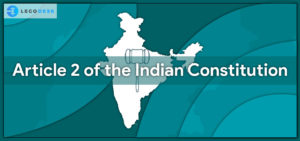Article 2 of the Indian Constitution

Introduction
India is a ‘Union of States.’[1] At present, the Indian Territory comprises of 29 states along with 7 Union territories. Part I (Article 1 – 4) of the Indian Constitution deals with the union and its territories. Article 2 under the same entrusts the parliament with powers regarding the admission or establishment of new states.
Parliament’s Power Under Article 2
Article 2 of the Indian Constitution provides the parliament with the power of enacting a law in order to admit into the union, or establish new States ‘on such terms and conditions as it thinks fit.’ However, Article 2 does not cover the establishing or admission of a Union territory. In order to admit a Union territory, a constitutional amendment under Article 368 is to be passed.
Try Your All in one legal practice management software – Sign Up Now!
The phrase, ‘on such terms and conditions as it thinks fit,’ introduces the element of parliamentary discretion into the provision. However, in the case of Mangal Singh v. Union of India[2] the court adjudged that this power of parliament cannot override the constitutional scheme and such terms and conditions should be in consonance with the basic features of the constitution. The said words mean that within the framework of the Constitution, it is permissible for Parliament to prescribe terms and conditions on which a new State is admitted in the Union.[3] In addition to this, the power which the Parliament may exercise by law is supplemental, incidental or consequential to the admission, establishment or formation of a State as contemplated by the Constitution.[4]
Article 4 of the Constitution clarifies that admission of a new state can be made through a simple majority, and an amendment under Article 368 is not required for the same.
Controversy of Sikkim
The 35th Amendment Act inserted Article 2A and 10th schedule to the Indian Constitution in 1974. Sikkim was to be within the associated with the Indian Union. However, it would not be a part of Indian Territory. Sikkim was to have two representatives to the two houses. The defense, communications, external affairs, and social welfare of Sikkim was to be under the Government of India. However, the Government of Sikkim retained all the residuary powers. The relationship between India and Sikkim was that of a protectorate-vassal state.
Article 2 only empowers the Parliament to admit a new state into the Indian territories. However, through this amendment, the Government tried to introduce the concept of ‘associated state.’ This concept had no mention in the Constitution earlier.
The criticism lost its significance since the Parliament, through the 36th Amendment Act (1975), admitted Sikkim into the Union. Article 2A was repealed, Article 371F was introduced and 1st, 4th Schedule was amended respectively. Thus, Sikkim became the 22nd State of India on 26th April 1975.
Difference between Article 2 and Article 3
Both Article 2 and 3 of the Indian Constitution deal with the States and Union territories. Article 2 grants two powers to the parliament:
- Admission of states which are already in existence.
- Establishing new states which were not in existence previously.
However, Article 3 authorizes parliament to:
- form a new state by separating a territory of any state, or by uniting two or more states or parts of states, or by uniting any territory to a part of any state;
- increase the area of any state;
- decrease the area of any state;
- alter the boundaries of any state;
- alter the name of any state.
Comparing both these provisions makes it quite evident that Article 2 deals with establishing or admission of a new state from outside the Indian Territory, however, Article 3 provides the power to create a new state from the existing states. It also provides certain powers to the parliament to change the territorial boundaries of such states.
During the drafting of the Indian Constitution, Mr. Naziruddin Ahmad (a member of the drafting committee) suggested that Articles 2 and 3 overlapped to a large extent and must be amalgamated. He proposed for a single provision, i.e., Article 2, which would carry within itself the powers authorized to parliament by Article 3. However, the proposed amendments by Mr. Ahmad were negatived by the Drafting committee through a consensus without any explanation for their decision.
Conclusion
Part I of the Constitution lays down a base for the newly emerging states and thus, is the foundation of the Constitution. An essential power is vested upon the Parliament. There is provision for the discretion of parliament. However, the judiciary over time has looked into the scope of such discretion and adjudged accordingly. Thus, this system of checks and balances ensures that the constitutional framework is not breached.
[1] Article 1(1), Constitution of India 1950.
[2] AIR 1967 SC 944.
[3] R.C. Poudyal v. Union of India, AIR 1993 SC 1804.
[4] Supra note 2.
Try our Debt Resolution solutions today Request a Demo